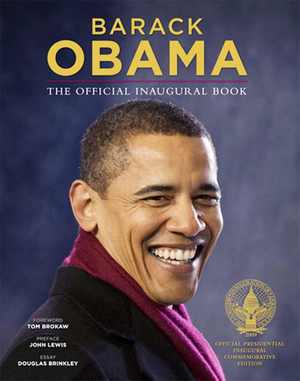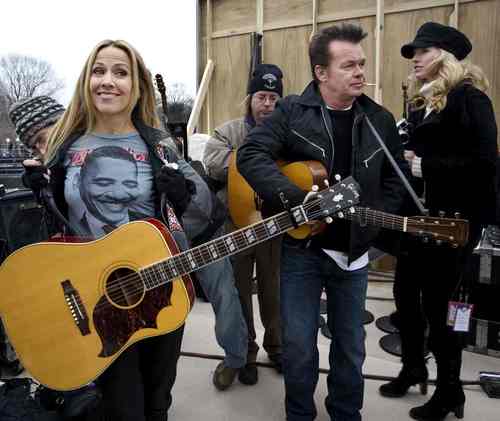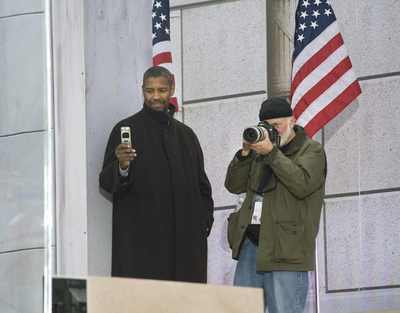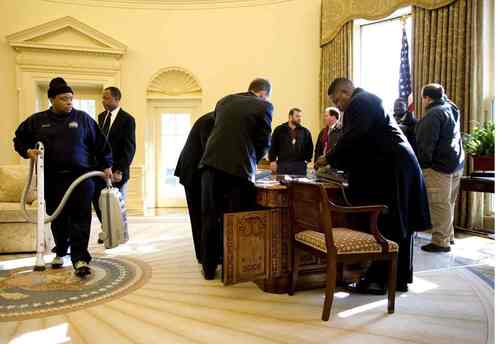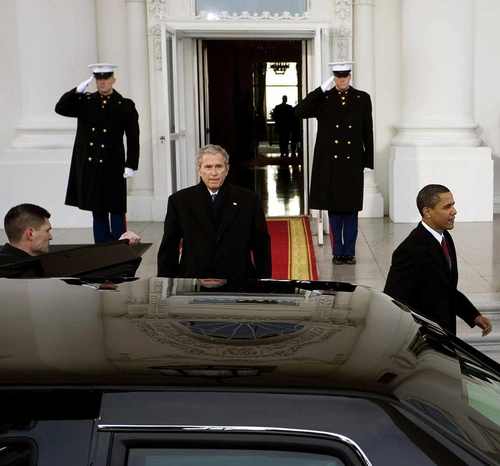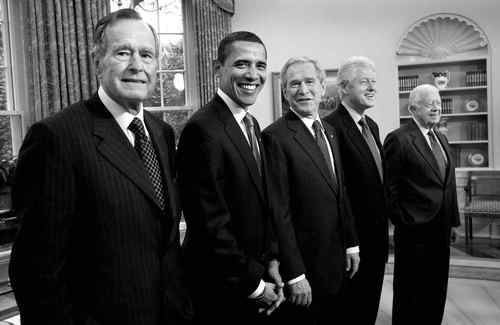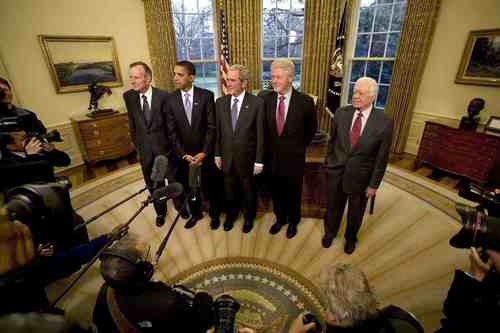If journalism is a front row seat to history, photographer David Hume Kennerly has been sitting in the VIP section. At seemingly every major political event that is photographed for history, one can catch a glimpse of Kennerly hard at work, either right in the heart of the action or just off to the side of the stage, shooting from the wings.
His subjects have included American Presidents and the candidates who aspire to be President, kings and queens, emperors, tyrants, First Families, Supreme Court Justices, soldiers, athletes, rock stars and ordinary U.S. citizens casting their votes at the ballot box.
At the age of 25, Kennerly won a Pulitzer Prize in Feature Photography for his images showing the 'loneliness and isolation of war' in Vietnam. Since then he's photographed seven additional wars and eight U.S. Presidents, traveled to 140 countries, and served as then-President Gerald Ford's personal White House photographer.
Over the course of his 40-year career, Kennerly has shot for Time Magazine, George Magazine, Life and Newsweek, and has published several books of his work: Shooter; Photo Op; Seinoff: The Final Days of Seinfeld; Photo du Jour; and Extraordinary Circumstances: The Presidency of Gerald R. Ford.
His latest publication, Barack Obama: The Official Inaugural Book, was released in April, 2009. An exhibition of photographs from the book is on display at the Smithsonian's National Museum of American History in Washington, D.C., until mid-July, 2009.
Kennerly, who in addition to being a world-renowned photographer is also a delightful character, sat down for a wide-ranging interview on everything from the Inauguration of America's first black President to his decades spent shooting pictures in the corridors of power, and from First Pets to that 'prom night' moment with the First Couple in an elevator.
1. Your new book, Barack Obama: The Official Inaugural Book, features photos from amateur photographers. Why did you decide to include these shots alongside those from award-winning photographers like yourself?
There was a core team of photographers: Bob McNeely, who was Bill Clinton's photographer; me; Paul Morse, who was a photographer for George W. Bush; Karen Ballard, who has the most pictures in the book; Pete Souza, who is now Obama's White House photographer. And we thought it was important that everybody be a participant in the book so we used this service called Photobucket and people uploaded their photos. And they were all considered. There were some pros who did it and there were some regular folks.
2. What did that add to the book?
It broadened the vision of the book and it expressed what was such an overwhelmingly emotional reaction to the Obama Inauguration. The whole idea was to capture that in images.
3. Let's talk a little bit about the days leading up to the Inauguration. You covered the concert at the Lincoln Memorial with everyone from Bruce Springsteen to Pete Seeger and U2. What was that like?
I'm not a big concert go-er, but I've seen some good ones in my time and this was one of the best. I was backstage and getting pictures of people like Sheryl Crow where she pulled back her shirt and had the Obama t-shirt underneath it.
I'll tell you one funny thing, I was standing next to Denzel Washington and we were kind of in the wings out there where the Obamas were sitting in the front, and this really beautiful woman comes out. And I said to Denzel, "Wow who is that?" He said, "That's Beyonce!" like, "You idiot." I said, 'Well she is really something to look at." And he said, "And she can sing." I didn't know who that was! I knew who Pete Seeger was -- he was one performer up there who was way older than me, so I had to appreciate him. Bruce Springsteen, everybody, they just put on such a good show. The thing about it was it was very personal -- it wasn't just another show.
4. I was in the crowd that day and the concert was amazing.
The book, if you were at the Inauguration or any of the events, it's the perfect souvenir for remembering what it was like. And if you weren't there, it will make you feel as if you had been. And that's why the book really works.
After the end of the show I went back out behind the Lincoln Memorial where they had the bus set up for the Obamas. It was the first time I'd really spent any time at all with Obama as a close-in observer, because I didn't cover the campaign. And what I saw was a remarkably relaxed guy, who doesn't take himself that seriously -- but he's a very serious person, certainly. But I really liked being around him. He was about as easy a guy to deal with as you could ever have in that position.
5.Where were you on Inauguration day?
Ever since Nixon departed the South Lawn of the White House, I have endeavored to be there when the change of power occurs. I watched Nixon take off from South Lawn on that very dramatic day, and then I was there when Ford walked out of the White House with Jimmy Carter on the way up to the Inauguration, and Ford had lost the election. I was there when Jimmy Carter walked out and left with Ronald Reagan after being beaten. I was there when George H.W. Bush walked out of there with Bill Clinton.
The thing I find fascinating is the transition in the Oval Office. So I just stayed at the White House, I didn't go to the Hill.
And you can see pictures in there -- which included moving day, you know bringing the Obama family items into the White House. That's a picture nobody's ever seen -- it was actually moving day like anybody's moving day except you're going into the White House.
6.It must be a little strange to observe these ordinary moments taking place in such an extraordinary setting?
Exactly. And the whole idea of that picture was to try to personalize it. So it was the perfect shot -- the moving guy's got one of the kids' red suitcase and then there's the White House in the background. So that's all you need for that picture. And then there's the close-up of the Hannah Montana poster. It really personalizes it and gives a sense of intimacy about it. Here's this family moving into the White House -- you know, a young family with two kids, I mean gimme a break. And they don't seem like your typical folks you'd expect to see coming to the White House.
And then there's the transition inside the Oval Office itself. The GSA guys or whoever, changing the buttons on the President's phone -- taking Rove off and putting Rahm Emanuel in. That was that picture! And the guy with the vacuum cleaner.
7.I know that one of your favorite pictures in the book is of George W. Bush and Barack Obama leaving the White House together after having coffee on the morning of the Inauguration. Right?
That is a significant photo for many reasons. There were a lot of people really happy to see Bush go. But for me it's not that. For me, this is the peaceful transformation of power. Obama's getting ready to walk around to the other side of the car -- which is the last time he'll ever do that.
The other part of that was that Bush never looked back. He got into the car, walked out the door, he didn't have a wistful gaze over his shoulder. He left and that was that, which was sort of his personality. He doesn't look back. That's the good news and the bad news probably. But introspection is not his strong suit.
The significance of that was obvious. And I nailed the picture because I was right in a place over the car, head on, and for some reason there weren't many people out there. And so I just got that snap -- and I knew what I was doing. You don't know what it's going to look like but it materialized in a way that I was happy with it.
I think the hugging picture [of Barack Obama and George W. Bush] on the Hill after Obama became President was a significant shot. Them walking out of the White House together and them having that hug -- that's what our country is all about... despite all the divisiveness. The fact is that's all part of the process, which is why we can flourish in our profession here, and it's why the process works. This didn't happen at the point of a gun and it wasn't chaos on the streets. It was just the two guys having that moment.
8. You traveled in the motorcade with the Obamas to the Inaugural ball that night and took a picture of the President and First Lady in a freight elevator. It is such an intimate moment between the two of them. This is one of my favorite pictures.
It's like prom night! It's like the noble high school kid is going to give his freezing date his jacket. It's almost timeless. That picture could have been taken in the 40s at the high school dance and that's how it felt to me at the time.
And I like the picture. The two other photographers in the elevator at the time, Pete Souza and Callie Shell, both had kind of different angles on it... But this one, there was nobody in the background. I just like that it was isolated. Mainly because it was about them -- it wasn't about the other people standing there.
And I didn't feel, because we were kind of off to the side, it wasn't like it was done for us. I would swear on a bible that was just how the Obamas are, and everything I know about them would corroborate that, from people who have been around them a lot more than I have.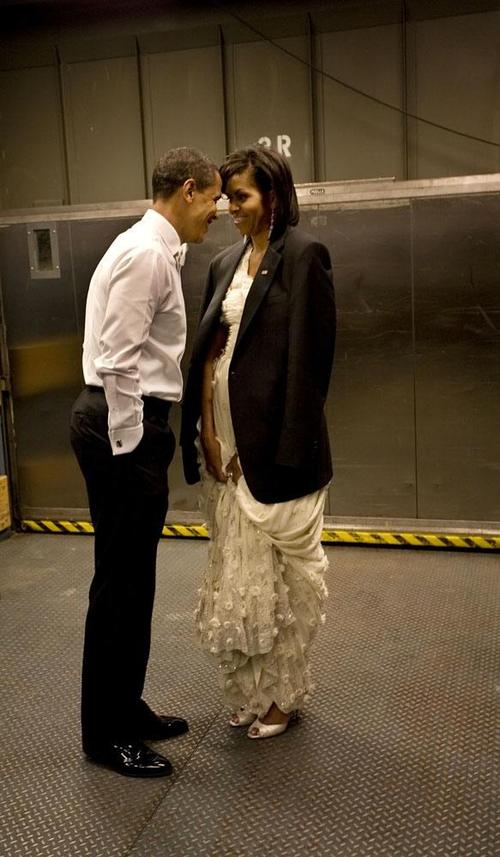
9.How do you shoot a picture like that without disturbing the subjects or intruding on what's obviously a very private moment?
That's the perfect question. Because it underscores how I and people like Pete Souza and Callie Shell do our work -- we try to stay out of their face and away. And we're just used to working in those private situations. [People ask], 'How can this be a real intimate moment when there are all these people standing around?' And the fact of the matter is, people like the Obamas are used to having other people around all the time and that's how they're gonna have to live, pretty much. And so it is possible to have a tender moment even when other people are around -- and the trick is not to influence it in some way.
I mean, would that have happened if we hadn't been in there? Yes. So fortunately we were in there and we were able to take the picture. And as you can see from some of the other angles from Pete or Callie, there were Secret Service guys, there were aides, it was a huge freight elevator. There were probably 20 people in the elevator, but it was big so it wasn't like we were all on top of each other necessarily. It's just a real live moment. It wasn't a Hollywood moment -- and I know the difference between the two. For instance, when you saw Bill Clinton and Hillary being schmoozy in public -- I didn't believe it. And I think anybody who ever covered him didn't, because basically Hillary wanted to hit him over his head with her purse, particularly after the Lewinsky matter.
10. You've covered every president since Richard Nixon. Is there a separate private side to what we see in public?
Well, I hope. Remember how Nancy Reagan was made fun of for having that adoring stare at her husband? Well, both of them were actors. But more important, she loved the guy! And it wasn't an act even though she was ridiculed for it. I spent a lot of time with them and he was a nifty guy. I mean he was fun to be around, like Obama is and like Clinton is, too. Most of these people are fun to be around, the ones that I spent the most time with.
I have a picture of the Reagans on the Truman balcony that I shot from inside the room through the window. And they are kind of holding hands and looking at each other and talking. So that picture went up to Time -- I was shooting for Time, I can't remember what the story was -- but they didn't use it. The editor said it was too schmaltzy. And I said, 'They are schmaltzy!' There's nothing wrong with that. That's the way they are. I don't make this s**t up. I'm not directing them. For one thing, there was a glass window between me and them. And it's a nice shot. Listen, there could not have been a more affectionate relationship than Ronald Reagan and Nancy Reagan. Could not have been. And it was genuine. And I never heard or saw anything different from that. And Nancy could be a tough person and I think people resented her for that -- but so what?
11. How do you deal with shooting the First Family? Is there anything that is off-limits?
Well, I can really only speak to my Ford experience -- because I was almost part of the family there, really. There was never anything off-limits to me. You have to look back at the history of the White House photographer's job. Each one of our access -- the access that we had depended on the relationship with the President, or whatever the President had in his mind. In the case of Lyndon Johnson, Johnson thought everything he did was important and wanted everything photographed, essentially. And he was very vain and he approved photos and if he didn't like a picture it didn't go out. However, he was a really interesting photographic subject -- may have been the most in our recent history, in terms of just a dramatic human being.
And then there was Nixon, whose photographer Ollie Atkins had extremely limited access. And the Oval Office -- his going in and out was controlled so he basically took three or four shots at the top of the meeting and then was out of there. He never could hang out in the Oval Office. And he was my model for how I didn't want to do the job.
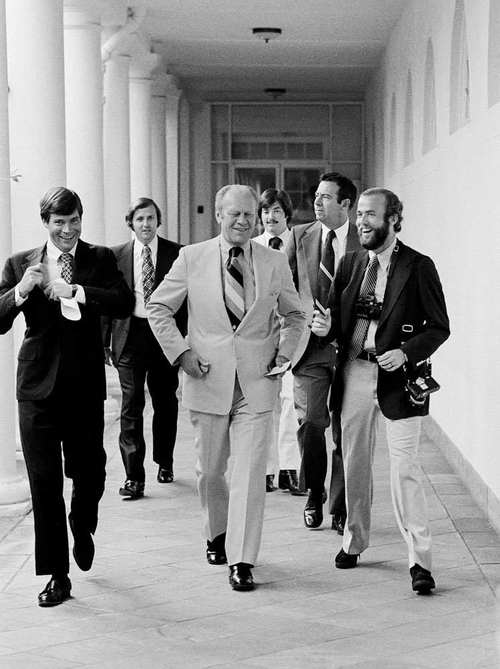
(White House photo, 1975)
And when Ford got the job, it became the exact opposite. Because I told him before I would take the job that the only way I could do it was to report directly to him -- I had no other boss and that I would have total access. Those were the two things that he agreed to, which was all I wanted -- it was the sum of my demands. And that's how it worked out. I also had my own relationship with Mrs. Ford, which allowed me to go upstairs/downstairs. And that is unique in its own right.
And people could see what I saw, which is the whole idea of being a photographer anyway.
12. Do you feel like you are documenting for history? Are you trying to let us see a little bit into their personal lives? How do you approach it?
Yes, all of the above. I think the historical part is the overriding reason for doing it and everything else sort of comes along.
Part of the ancillary benefit of having the kind of access I got just led to having a lot of backstage pictures with all these world leaders at the time. From Brezhnev, to Deng Xiao Ping to Tito, and remote figures that you never would have seen normally if you'd been covering them, the Emperor of Japan. And the pictures are very intimate with these people so it gives you some insight into their personalities, as well.
13. Is there one President who you would say was most comfortable in front of the camera?
Reagan was very comfortable, just because he had the camera in his face all of his career as an actor and as a politician.
And Reagan was more of a 9-5 guy and upstairs was pretty well off-limits. That was Nancy-land, Nancy-stan as somebody put it. But you know, that's the way she ran it. And listen, I mean you work for those people and the relationship you have with them is how it all works out. Every single individual is different and that's reflected in the pictures.
Bill Clinton was comfortable except I always had the feeling he was looking at me out of the corner of his eye wondering what I was up to. But I did have backstage time with him and he's a great subject, I really enjoyed being around him.
And again, there was that DMZ between the East Wing and the West Wing. With Hillary, you crossed over and it was like you needed a visa to go to the East Wing from the West Wing. She had her group and Bill Clinton had his and never the twain would meet. So you didn't have the all-access pass like I had -- I mean Bob McNeely [Clinton's White House photographer] would freely admit that.
14. So what do you make of this -- we've got a young family in the White House, two kids, they've got a dog...
You cannot ask for a better situation for a photographer. It's like dying and going to photographer's heaven with the Obamas! Gimme a break! Not since Jack Kennedy and the kids. Absolutely unbelievable.
15. As a photographer, do you ever feel like you're being co-opted?
Of course -- but not in a bad way! The fact is, they didn't rent their kids and they didn't rent the dog.
President Ford had Liberty, a golden retriever. And I will tell you this flat out -- a golden retriever is one of the most telegenic dogs around. You can't go wrong with a golden retriever, they are always so nice to look at. Unfortunately, the Obama dog is sort of this ball of fur which is kind of hard to photograph, and I've heard complaints about that from certain reporters. If the photographers had to pick a dog -- it wouldn't be a Portuguese Water Hound, or whatever you call it. They would go directly to the spaniels like the Kennedys had, or the retrievers like President Ford had, or an Irish setter like the Nixons had.
16. Does this personal relationship, like the one you had with the Ford family, affect the way that you shoot them?
I think because I am so professional about what I do -- the personal relationship gets me into the room, the professional never leaves my head. So I'm photographing, even at difficult times, not to make people look good or bad but just to really try to get to the heart and soul, with my camera, of what's going on.
The point is neither I nor Michael Evans [Reagan's White House photographer] or Pete Souza [Obama's White House photographer] checked our professionalism and integrity at Oval Office door when we went in to become the White House photographer. Part of the reason we were hired was for our background and ability to work up close and personal with people, without knocking over the lamps, and giving an honest portrayal. And when I left the White House, President Ford wrote me probably what is the nicest letter anybody could ever get from a boss, talking about the fact that I showed them as they were. And that's all that he would've cared about.

